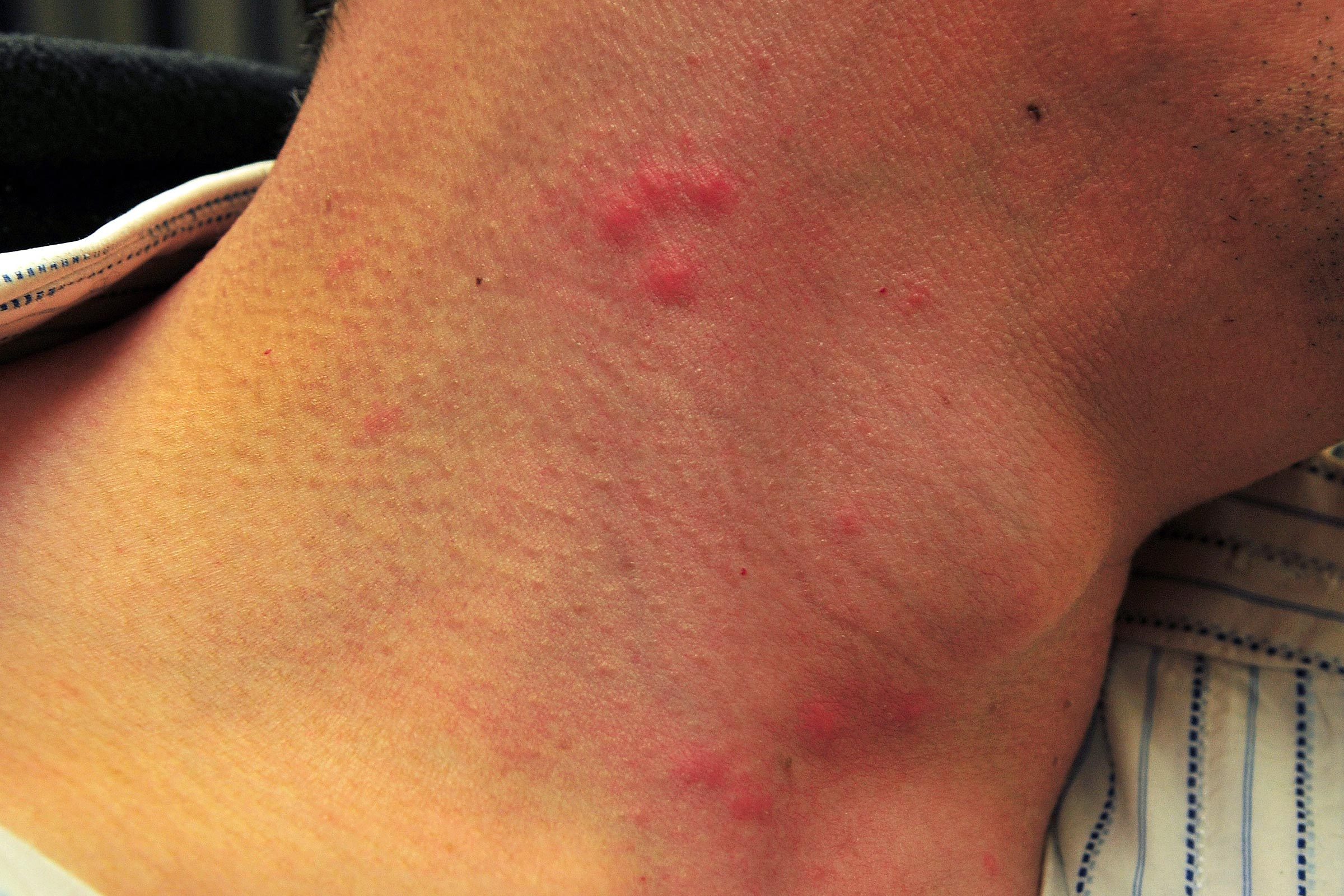
Unfortunately, a bed bug bite has no telltale sign, according to a review published in the American Society for Microbiology. The reaction to bites varies tremendously from one person to the next. Some people will have no reaction or just minor itching and mosquito-like bumps in one area; others will get dramatic red raised welts all over. “It depends on the number of feeding bugs on the body, how long the person has been suffering bites, and also where the bites are located,” says Jody Green, PhD, an urban entomologist at the University of Nebraska-Lincoln.
Five stages of post-bed bug bites
If you have evidence of bed bug bites on your skin, it’s due to your body’s allergic response, according to the U.S. Armed Forces’ 2019 Pest Management Board: Technical Guide #44. That response can take a few different forms: little to no reaction; an immediate reaction—often a red spot with minor discomfort; a delayed reaction in which red weals turn up within 14 days that trigger intense itching that can last two to five days; or, unfairly, a combination of immediate and delayed reactions. This makes it tough to know what’s gnawing on you without the help of an entomologist or dermatologist. Although this guide to bug bites may help.
Familiar signs of bed bug bites
While there is no exact way to tell what bug bit you, dermatologist A. Yasmine Kirkorian, MD, an assistant professor of Dermatology & Pediatrics, Children’s National Health System, says there are some patterns doctors look for: “Bed bugs typically bite several times in a row so people may notice several red itchy bumps grouped closely together, a pattern sometimes called ‘breakfast, lunch, and dinner,'” she explains. “They can occur anywhere on the body; bed bug bites on the face may cause intense swelling including of the eyelid.” A small study found that 72 percent of people who were bitten by bed bugs had itchy red welts, 50 percent had redness or discoloration, and 28 percent had itching with no welts. Call your doc or dermatologist and look for these signs of bed bugs in your house.
It can’t be bed bug bites
Let’s say you are sleeping in the same bed as your partner and your partner wakes up with bites but you don’t. Must not be bed bugs, right? Sadly, it still could be. “The most challenging thing about bed bug bites is that there is are people who do not react to bed bug bites, so they have no adverse skin responses and have no idea that they are being fed upon while they are sleeping,” says Green. One survey found that nearly one in three people had no reaction to bed bug bites. When the researchers broke out reactions by age, they found that 42 percent of people over 65 had no reaction. Bites or no bites, this is how bed bugs could get in your bedroom.
Bed bug bite treatment
People who do react to bed bugs often have intense itching. “Once a patient has been bitten, it is difficult to eradicate the itching. Over-the-counter anti-itch creams that contain one percent pramoxine can help,” says Dr. Kirkorian. Try Aveeno with pramoxine and calamine. Oral antihistamines such as Zyrtec and Benadryl may be effective too, says Dr. Kirkorian. But if your itching persists, your dermatologist or doctor might prescribe topical steroids such as triamcinolone and fluocinonide.
Just thinking about bed bugs can wreck your sleep, as well. Talk to your doctor if you start suffering from insomnia. “A sedating antihistamine such as Benadryl could be safe to use,” says Dr. Kirkorian.
Home remedies for bed bug bites
Before you commit to natural bed bug treatment, remember to practice good hygiene and caution, advises Larry Bishop, MD, a dermatologist with Health First Medical Group: Be sure to wash the area with soap and water first to reduce the risk of infection; if the area appears irritated or develops a rash, stop using the treatment and see a doctor. For remedies, Dr. Bishop suggests trying peppermint oil: “It works by two mechanisms—the peppermint oil is a vasoconstrictor (blood vessel constrictor), which lessens the pain and irritation from bed bug bites. Additionally, the peppermint works as a soothing agent by gently stimulating the nerves around the bite.” Try adding a few drops to a warm bath; if you want to apply it to the bites, dilute it first with an oil such as coconut, jojoba or olive.
Lemon balm is another favorite for bug bites. Crush or roll the leaves with your fingers to release the juice, apply it to the bites, and wrap with a bandage. “It works by having soothing properties and antibacterial properties,” Dr. Bishop says. Finally, there’s household ammonia—research suggests that it can help with itchy bites. It may not smell great, says Dr. Bishop, but if you put a little on a cotton ball and dab it on the area right away, it can help. “It works by neutralizing the proteins that are in the saliva of the bed bugs.” The saliva is what produces the allergic reaction in some people, and the quicker you neutralize it, the better.
When to see the doctor
Your bed bug bites will generally clear up on their own, but if you itch them the scratching can lead to secondary infections. “The initial bite may be a portal for bacteria to enter the skin. If a patient develops a worsening red bump, pus drainage, a fever, or other signs of systemic illness, they should seek urgent medical attention,” advises Dr. Kirkorian. Then, find out how to get rid of bed bugs.
The post How to Identify Bed Bug Bites—and How to Treat Them appeared first on Reader's Digest.
from Reader's Digest http://bit.ly/2Lgytv9
How to Identify Bed Bug Bites—and How to Treat Them Reader's Digest
Нема коментара:
Постави коментар